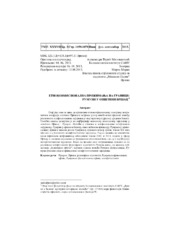Приказ основних података о документу
Етноконфесионална прожимања на граници: Румуни у општини Вршац
| dc.creator | Đurić-Milovanović, Aleksandra | |
| dc.creator | Maran, Mircea | |
| dc.date.accessioned | 2019-03-19T19:39:10Z | |
| dc.date.available | 2019-03-19T19:39:10Z | |
| dc.date.issued | 2013 | |
| dc.identifier.issn | 0353-7919 | |
| dc.identifier.uri | http://teme2.junis.ni.ac.rs/public/journals/1/previousissues/teme3-2013/teme%203-2013-01.pdf | |
| dc.identifier.uri | https://dais.sanu.ac.rs/123456789/5088 | |
| dc.description | Romanians; Vršac; religious identity; the Romanian Orthodox Church; the Romanian Greek-Catholic Church; neo-Protestants | en |
| dc.description.abstract | Овај рад има за циљ да представи етноконфесионалну панораму пограничног подручја општине Вршац и истражи улогу симболичке границе измеђуразличитих конфесионалних заједница у овој мултикултуралној средини Баната.Посебна пажња усмерена је на најбројнију мањинску националну заједницу уопштини Вршац – Румуне. Живећи у етнички и конфесионално хетерогеномокружењу, Румуни у српском Банату, иако већином припадају Румунској православној цркви и мањим делом Румунској гркокатоличкој цркви, током XX векапрелазе и у различите неопротестантске заједнице. Рад се заснива на квалитативном теренском истраживању обављеном током 2012. и 2013. године у граду Вршцу и околним насељима са румунским становништвом, где су и најбројније неопротестантске заједнице. Један од циљева овог истраживања односио се на указивање хетерогености религијског идентитета Румуна данас, на анализу перцепције „религијски другог“, верских односа између Румуна православаца, Румуна гркокатолика и припадника неопротестантских заједница. | sr |
| dc.description.abstract | This paper aims to present the ethno-confessional panorama present in the border area of the town of Vršac and explore the role of symbolic borders between the different confessional communities in this multicultural environment of Banat. Special attention is given to the largest ethnic community in the municipality of Vršac – Romanians. Living in the ethnically and religiously heterogeneous environment, Romanians in Serbian Banat also joined different neo-Protestant communities during the 20th century, although they mostly belonged to the Romanian Orthodox Church and, to a lesser extent, to the Romanian Greek-Catholic church. This paper is based on a qualitative field research conducted during 2012 and 2013 in the town of Vršac and its surrounding area containing Romanian population, where the neo-Protestant communities are the most numerous. One of the goals of this research was to point out the heterogeneity of religious identity of the Romanians today and to call attention to the analysis of the perception of “the religious other”, i.e. the religious distance, between Orthodox Romanians, Greek-Catholic Romanians, and members of the neo-Protestant communities. | en |
| dc.language | en | |
| dc.relation | info:eu-repo/grantAgreement/MESTD/Basic Research (BR or ON)/177006/RS// | |
| dc.rights | openAccess | |
| dc.rights.uri | https://creativecommons.org/licenses/by-nc-nd/4.0/ | |
| dc.source | Теме | |
| dc.title | Етноконфесионална прожимања на граници: Румуни у општини Вршац | sr |
| dc.type | article | en |
| dc.rights.license | BY-NC-ND | |
| dcterms.abstract | Ђурић-Миловановић, Aлександра; Маран, Мирцеа; | |
| dc.citation.spage | 1059 | |
| dc.citation.epage | 1078 | |
| dc.citation.volume | 3 | |
| dc.type.version | publishedVersion | |
| dc.identifier.fulltext | https://dais.sanu.ac.rs/bitstream/id/16062/bitstream_16062.pdf | |
| dc.identifier.rcub | https://hdl.handle.net/21.15107/rcub_dais_5088 |

